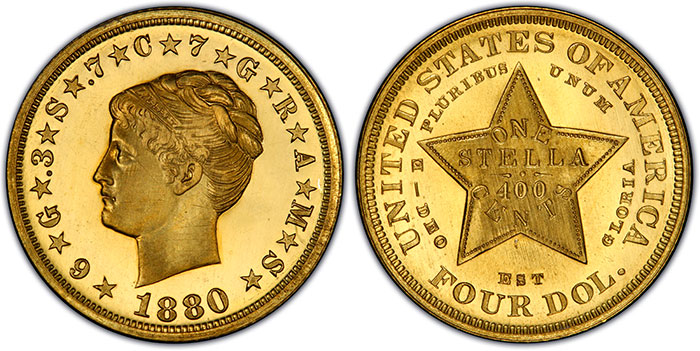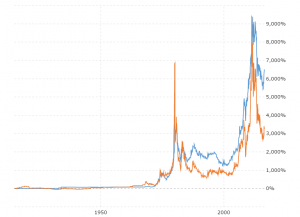America’s One and Only Four-Dollar Coin
A four-dollar coin you say? Who ever heard of such a thing? Well coin-collectors certainly have, and it certainly exists. In 1865 France, Switzerland, Italy and Belgium got together to produce a standard coin for exchange between different currencies. It was based on the 20-franc gold coin of 6.45 grams of .9000 gold. Considering the development of an equivalent coin, the American Congress asked the US Mint to create a pattern coin – that is, a design prototype – of a suitable coin. The Mint came up with a design for a gold coin that contained 6 grams of fine gold – a little more than the 5.81 grams in the French coin.
The design was created by Charles E. Barber, the sixth Chief Engraver of the United States Mint. This fresh new designer, who had just taken over from his father, William Barber, worked with a mint engraver called George T. Morgan, and together they came up with two designs. Morgan created a traditional Lady Liberty for the obverse, with her hair coiled in a bun. Barber, perhaps wanting to stand out, created a novel design depicting Lady Liberty with flowing hair coiling down around her shoulders. In the prototypes, Morgan’s design in dated 1879, and Barber’s 1880. Around both o the reverse is the inscription “★6★G★.3★S★.7★C★7★G★R★A★M★S★“, giving the gold (6 grams), silver (0.3 g) and copper (0.7g) content of the coin. The coin is 22 mm across, and 1.52 mm thick, with a reeded edge.
On the reverse is a large five-pointed star with the words ONE STELLA and 400 CENTS inside it. The inscriptions E PLURIBUS UNUM (“Out of many, one”) and DEO EST GLORIA (“To God is the glory”), are arranged between the points of the star. Around the rim of the reverse is UNITED STATES OF AMERICA and FOUR DOL.
The coin is called a Stella, meaning ‘star’, which was proposed as the name of the new international currency. Despite intense lobbying from the House Committee on Coinage, Congress rejected both the idea of joining this European venture (called the Latin Monetary Union), and the Stella itself. While the idea was being debated, the US Mint struck 425 flowing-hair Stellas and just 20 coiled-hair versions. To recover the production costs of making these trial coins, the Mint sold them to Congressmen. A scandal erupted when women from some of Washington’s most famous (or infamous) brothels were seen around town wearing the coins as jewellery, presumably because they had been given them as gifts by admiring Congressmen.
Given this dramatic story, and their very limited production, Stellas today are among the rarest and most sought after of American coins. There are believed to be just a dozen or so still in existence. The flowing-hair 1879 version has an estimated value of $500,000 to a million dollars, depending on the quality, while an example of the rarer coiled-hair 1890 version, in top condition, was sold in September 2013 at Bonham’s Auction for $2,574,000.
While such coins are of course out of the reach of almost every collector, their fascinating stories enrich the lore of collecting. And of course, there is always the one-in-a-million chance of finding one in an attic, or at your local trunk sale. Stranger things have happened.

















